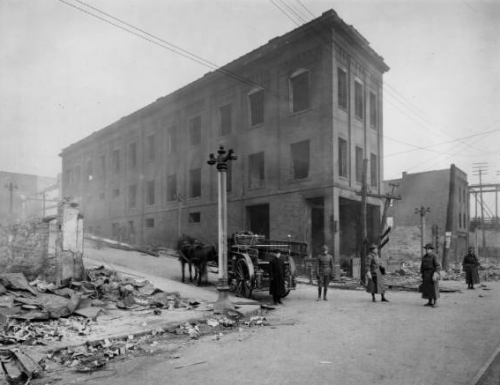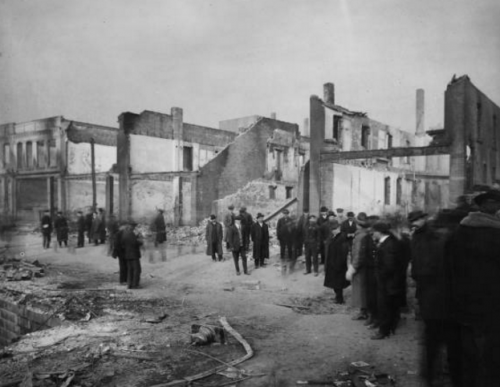Hellraisers Journal: The Outlook on the Youngstown Strike, Private Detectives & Immigrant Workers
Put on your fighting clothes.
-Mother Jones
~~~~~~~~~~~~~~~~~~~~~~~~~~~~~~~~~~~~~~~~~~~~~~~~~~~~~~~~~~~~~~~~~~~~~~~~~~~~
Thursday January 20, 1916
From The Outlook: Speculations on Causes of Youngstown Strike & Riot
From The Outlook of January 19th:
YOUNGSTOWN: THE STRIKE
-----
Ohio National Guard on duty in ruins of East Youngstown.
``````````If it is true, and we have not seen it contradicted, that the battle in Youngstown, Ohio, in which several men were shot dead and many others wounded was one between detectives hired by employers, and strikers, and was on the public street, then that fight and those deaths were a disgrace to town, county, and State. Private detectives, hired by one party to a quarrel, are not the guardians of public order; they correspond rather to the paid bravos of mediaeval private war.
Youngstown, with its suburbs, may include a hundred thousand people. A third of this total population, it is said, consists of unnaturalized foreigners—chiefly Poles, Lithuanians, and Serbs; indeed, almost all the persons who were arrested the other day for rioting could not speak English. The Youngstown outbreak consisted of two distinct events: first a strike, and second, a riot. The strike was the result of a demand for increased wages. The men asked this because they felt that they were not getting their share of the profits now coming to the steel industry. This industry has experienced a wave of prosperity as we compare its present condition with that of last year, when a number of prominent concerns, though maintaining wages, lost money. While at the beginning of the European war the steel business was depressed, by the end of the war's first year prices and tonnage had begun to advance so rapidly that last month almost every steel plant in the country was running at as nearly one hundred per cent capacity as was practicable.
The price of the shares of the various steel concerns had risen with even greater rapidity; certainly much money has been made by those shareholders who have sold at top quotations what they had bought at low prices. Moreover, the outlook for the future was stimulating. Nearly all the companies have large orders ahead at prices promising substantial profits. This prosperity, however, has been exaggerated in the public press, perhaps inspired thereto by certain investment houses seeking to market securities.
The stories of fabulous fortunes quickly made were carried to about every home, high and low. The natural and inevitable result was that mill workers everywhere began to feel that they were not getting their share. Hence the demand by unskilled workmen at East Youngstown of a wage increase from nineteen and a half cents to twenty-five cents an hour and double pay for Sunday labor. The demand was met by a concession of about half. The men would not agree to this. Hence the strike. It appears to have originated in the Republic Iron and Steel Company's works, rather than in the Youngstown Sheet and Tube Company's plant, though the latter was the scene of the riot.
The Youngstown strike is really not an isolated event; the question of increased wages affects the steel industry throughout the country. Fortunately, the largest concern, the United States Steel Corporation, has forestalled trouble by voluntarily increasing its wages.
YOUNGSTOWN: THE RIOT
-----
The Ruins of East Youngstown.
``````````This strike, begun by day laborers and confined to day laborers, was entirely distinct, so trusted Youngstown correspondents inform us, from the riot. As the first day of the strike wore on and the men discussed their grievances, their rage against their employers increased in direct proportion to the drinks consumed. Finally they wanted more drink than they could pay for. They began to harry and then to raid the saloons in the neighborhood of the company's plant. In this they were assisted by many who were not strikers.
The total number of strikers was about thirteen thousand; but the mob finally grew to more than double that number. They broke the doors and windows of the saloons, which had now been hurriedly closed; they seized the opened bottles of whisky and gin and knocked the tops off the other bottles. At this juncture the mob obtained some dynamite by breaking into the storehouse of the local contractor, and with this they planned, as they said, "to blow East Youngstown to hell!" At the same time the mob tried to burn the enemy's plant. It did set fire to the business section of the town, and assaulted the firemen who were trying to fight the flames.
Unfortunately, at this juncture a stone was thrown at the twenty-five private detectives in the employ of the company who were at the entrance to protect the workers; where upon the detective leader fired his revolver, and his men, taking this as a signal, poured a volley at the strike leaders. Twenty of the strikers and two bystanders fell, eight of them fatally wounded. This private detective episode, referred to above, reminds one of the recent strike at Roosevelt, New Jersey, when private persons attempted to do what ought to have been done by the Government. This sort of struggle ought to be called by its true name—private war.
Governor Willis, having been notified of what was taking place, ordered five companies of militia from Cleveland and other near-by towns to East Youngstown. But the militia were late in arriving.
We are glad to read the statement of the Youngstown representative of the American Federation of Labor. He said, as reported:
The men who are on strike are not organized into a union and are not affiliated with any union organization....The American Federation of Labor representatives will have nothing to do with the strikers because of the pillage and burning of innocent people's property. When the Republic Iron and Steel Company's men went out on strike, we went down there and counseled them to do no violence. They followed our advice. When we learned yesterday that the Youngstown Sheet and Tube Company's men were threatening trouble, we went out to persuade them not to do any violence....The American Federation of Labor does not countenance violence in strikes and will have nothing to do with this one from now on.
The riot has destroyed both life and property, the latter amounting to many hundreds of thousands of dollars.
For this about two hundred foreigners were arrested, while wagon-loads of loot found in their homes, and varying from shoes to dressed pigs, were taken to the police station. These things, according to the police, had been stolen from the shops and stores attacked by the mob. Sixty-seven rioters were held for the Grand Jury on charges of riot, inciting to riot, or carrying concealed weapons. Fifty-three others, accused of minor offenses, were fined twenty-five dollars each, and sentenced to a thirty-day imprisonment; the remainder of those arrested were released.
There is, so far, no evidence, The Outlook is informed, to prove that the riot had been caused or incited by anti-war munitions agitators. On the other hand, the newspapers report that "paid sluggers and gunmen incited the riots."
Whatever the cause and incitements, the event should throw light not only on labor conditions but on those of immigration and the use of liquor. It should teach an impressive lesson in each domain.
[Photographs and paragraph breaks added.]
SOURCE
The Outlook, Volume 112
(New York, New York)
Ernest Hamlin Abbott, Lyman Abbott,
Francis Rufus Bellamy, Hamilton Wright Mabie
Outlook Co., Jan-Apr 1916
https://books.google.com/books?id=3URYAAAAYAAJ
The Outlook of Jan 19, 1916
https://books.google.com/books/reader?id=3URYAAAAYAAJ&printsec=frontcove...
"Youngstown: The Strike"
https://books.google.com/books/reader?id=3URYAAAAYAAJ&printsec=frontcove...
"Youngstown: The Riot"
https://books.google.com/books/reader?id=3URYAAAAYAAJ&printsec=frontcove...
IMAGES
Ohio National Guard patrols ruins of East Youngstown after Jan 7, 1916
http://www.ohiomemory.org/cdm/compoundobject/collection/p267401coll36/id...
East Youngstown in ruins after Jan 7, 1916.
http://www.ohiomemory.org/cdm/compoundobject/collection/p267401coll36/id...
See also:
"WE NEVER FORGET: The Roosevelt Massacre of January 19, 1915"
-by JayRaye
http://www.dailykos.com/story/2015/1/26/1359959/-WE-NEVER-FORGET-The-Roo...
``````````````````````````````````````````````````````````````````````````````````````````````````
There Will Be A Reckoning - Billy Bragg



